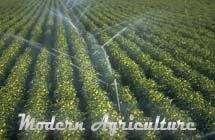Modern agriculture may lead to major disruptions of world’s water flows
 Washington, April 3 : Water experts have warned that modern agriculture and land-use practices may lead to major disruptions of the world’s water flows, with potentially sudden and dire consequences for regions least able to cope with them.
Washington, April 3 : Water experts have warned that modern agriculture and land-use practices may lead to major disruptions of the world’s water flows, with potentially sudden and dire consequences for regions least able to cope with them.
The water experts include researchers at the Stockholm University-affiliated Stockholm Resilience Centre and McGill University.
The researchers argue that global water management has been focused too much on the “blue water” side of the hydrological cycle, neglecting the largely invisible changes humanity has had on so-called “green water.”
“Blue water is the part of the cycle we can see, like streams and rivers,” said Dr. Line J. Gordon, an assistant professor at the Stockholm Resilience Centre and the Stockholm Environment Institute.
“This is as opposed to ‘green water’ in soil moisture, or evapotranspiration from plants, which agriculture can affect in significant ways,” he added.
“Resilience” describes the capacity of social-ecological systems to withstand climactic or economic shocks, and to then rebuild and renew themselves.
In their paper, the researchers look at the likelihood of that vital resilience being lost in the aftermath of catastrophic changes to the hydrological cycle that could be caused by agriculture and land-use practices.
“Our main point is that these effects aren’t necessarily going to result in gradual change,” explained Peterson, assistant professor in the Department of Geography and the McGill School of Environment.
“They can result in surprising, dramatic changes, what we call ‘ecosystem flips’ or ‘ecosystem regime changes,’ which can be very difficult or even impossible to reverse,” he added.
According to Peterson, recent outbreaks of toxic algae blooms in Quebec lakes and off Sweden’s Baltic Sea coast are prime examples of ecosystem flips, the consequence of nutrients from fertilizers permeating the soil and running off into streams, lakes and oceans.
Ecosystem flips can have significant and sometimes devastating effects on human well-being, as global populations suddenly lose resources they are dependent on, said the researchers.
Some of the most vulnerable areas on Earth are places like the drylands of sub-Saharan Africa.
“In some of these regions, we risk two types of ecosystem flips, one that causes rapid soil degradation with dramatic effects on yields and farmers’ livelihoods, and another that affects rainfall and therefore also vegetation growth,” said Gordon.
“These are the places where populations are growing the fastest, people have the least amount of water per capita and are the poorest of any of the biomes of the world. They are also the regions most likely to be affected by climate change,” said Peterson. (ANI)